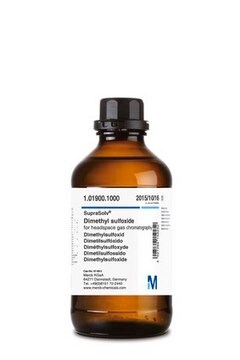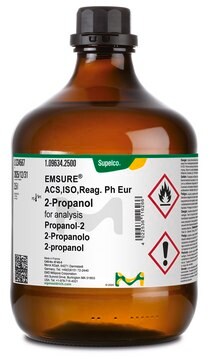270458
NMP
suitable for HPLC, ≥99%
Synonym(s):
1-Methyl-2-pyrrolidone, N-Methyl-2-pyrrolidone, NMP
About This Item
81-82 °C/10 mmHg (lit.)
0.99 mmHg ( 40 °C)
Recommended Products
Product Name
1-Methyl-2-pyrrolidinone, suitable for HPLC, ≥99%
vapor density
3.4 (vs air)
Quality Level
vapor pressure
0.29 mmHg ( 20 °C)
0.99 mmHg ( 40 °C)
Assay
≥99%
form
liquid
autoignition temp.
518 °F
purified by
glass distillation
expl. lim.
9.5 %
technique(s)
HPLC: suitable
impurities
<0.050% water
color
APHA: ≤10
refractive index
n20/D 1.47 (lit.)
pH
7.7-10.0 (20 °C, 100 g/L)
bp
202 °C (lit.)
81-82 °C/10 mmHg (lit.)
mp
−24 °C (lit.)
density
1.028 g/mL at 25 °C (lit.)
λ
H2O reference
UV absorption
λ: 285 nm Amax: 1.00
λ: 300 nm Amax: 0.50
λ: 325 nm Amax: 0.10
λ: 350-400 nm Amax: 0.01
application(s)
food and beverages
SMILES string
CN1CCCC1=O
InChI
1S/C5H9NO/c1-6-4-2-3-5(6)7/h2-4H2,1H3
InChI key
SECXISVLQFMRJM-UHFFFAOYSA-N
Looking for similar products? Visit Product Comparison Guide
General description
It also participates in the following:
- synthesis of cyanotrimethylsilane
- decarbonylation of aldehydes
- reduction of benzaldehydes and ketones to the corresponding alcohols
- preparation of natural products
Application
Signal Word
Danger
Hazard Statements
Precautionary Statements
Hazard Classifications
Eye Irrit. 2 - Repr. 1B - Skin Irrit. 2 - STOT SE 3
Target Organs
Respiratory system
Storage Class Code
6.1C - Combustible acute toxic Cat.3 / toxic compounds or compounds which causing chronic effects
WGK
WGK 1
Flash Point(F)
195.8 °F - Pensky-Martens closed cup
Flash Point(C)
91 °C - Pensky-Martens closed cup
Choose from one of the most recent versions:
Already Own This Product?
Find documentation for the products that you have recently purchased in the Document Library.
Customers Also Viewed
Our team of scientists has experience in all areas of research including Life Science, Material Science, Chemical Synthesis, Chromatography, Analytical and many others.
Contact Technical Service






